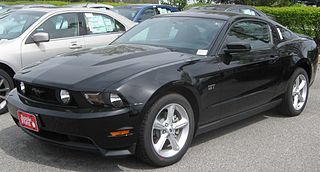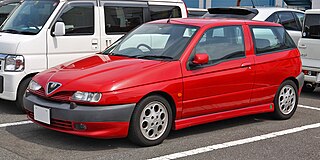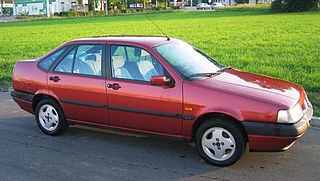
The Fiat Tipo is a compact car, designed by the I.DE.A Institute design house, and produced by the Italian manufacturer Fiat between 1988 and 1995.

The Ford D2C platform is one of Ford's rear-wheel drive automobile platforms.

The Alfa Romeo 164 is a four-door executive saloon manufactured and marketed by Italian automaker Alfa Romeo from 1987 to 1998, styled by Pininfarina, and cooperatively designed and sharing platforms and numerous elements with the Fiat Croma, Saab 9000 and Lancia Thema.

The Chapman strut is a design of independent rear suspension used for light cars, particularly sports and racing cars. It takes its name from, and is best known for its use by, Colin Chapman of Lotus.
The Tipo Quattro platform was a front wheel drive platform co-developed in the 1980s and 1990s and shared by the Saab 9000, Fiat Croma, Lancia Thema, and Alfa Romeo 164. The platform, ultimately in production for fourteen years, was the fifth and largest of Fiat's Tipo platforms, a numbering sequence that began with zero, hence "four".

The Alfa Romeo Brera and the Alfa Romeo Spider are mid-size sports cars using the GM/Fiat Premium platform, manufactured by Pininfarina and marketed by Alfa Romeo as a 2+2 coupé and roadster respectively.

The Alfa Romeo 145 and the Alfa Romeo 146 are small family cars produced by Italian automobile manufacturer Alfa Romeo between 1994 and 2000. The 145 is a three-door hatchback and was launched at the 1994 Turin Motor Show, while the 146 is a five-door hatchback, launched in 1995 to replace the Alfa Romeo 33.

The Lancia Beta, stylised as Lancia β, was an entry-level luxury car produced by Italian car manufacturer Lancia from 1972 to 1984. It was the first new model introduced by Lancia after it had been taken over by Fiat in 1969.

The Alfa Romeo GTV and the Alfa Romeo Spider are sports cars produced by the Italian automobile manufacturer Alfa Romeo from 1993 to 2004. The GTV is a 2+2 coupé, while the Spider is a two-seater roadster. Production totaled 38,891 units for the Spider and 42,937 units for the GTV.

The Lancia Dedra is a compact executive car produced by the Italian automaker Lancia from 1989 to 1999. It was initially designed to support, and went on to replace, the Prisma which, six years after its launch, was having difficulty remaining competitive in the market. It was based on a stretched version of the platform underpinning the second generation of the Delta and is often considered a saloon variant of the Delta.

The Lancia Lybra is a compact executive car manufactured and marketed by Italian automaker Lancia between 1998 and 2005, based on the Alfa Romeo 156 floorpan, and replacing the Dedra in Lancia's range. Like the Dedra, the Lybra was available as a Berlina (saloon) or a Station Wagon (estate). A total of 164,660 cars were made.
The Turin Motor Show is an auto show held annually in Turin, Italy. The first official show took place between 21 and 24 April 1900, at the Castle of Valentino, becoming a permanent fixture in Turin from 1938 having shared it with Milan and Rome until that time. From 1972, the show was held biannually and in 1984, it moved into Fiat's shuttered Lingotto factory.

The Alfa Romeo Protèo concept car was released at the Geneva Motor Show in 1991. It is a 2-door coupé cabriolet with folding roof, featuring a 3.0 liter quad-cam 24-valve, 60 degree V6 coupled with a 5-speed manual transmission, with a top speed of 250 km/h (155 mph). The engine used in Protèo produces 260 PS. The Protèo uses shortened floorpan used in Alfa Romeo 164 and features four wheel drive and steering. Many of the Protèo's design cues were influenced by the Alfa Romeo 916 series GTV/Spider, which was designed in July 1988. First design sketches by Alberto Bertelli are dated for December 1989. The name Protèo is derived from a Greek deity Proteus. Concept was presented in a dark metallescent red paintwork, that was later included in the Alfa Romeo range as Rosso Proteo.

The Fiat Mini platform is an automobile platform shared among city cars of the Fiat Group.
The Fiat C-platform was an automobile platform used in small family cars of the Fiat Group. The predecessors of the C-platform were the Tipo Tre and Tipo Due platforms, and the successor is the new Compact platform which debuted in Alfa Romeo Giulietta in 2010.

The Compact platform was developed by engineers of the Fiat group for the construction of small family cars and large family cars with front-wheel drive or four-wheel drive. The first incarnation of this platform was the Alfa Romeo Giulietta which was unveiled in 2010. Fiat has invested 100 million euros into the construction of the Compact Platform.

The Tipo Tre platform was a front wheel drive platform designed by the Italian Fiat Group and used during the 1980s and 1990s for a range of Alfa Romeo, Fiat and Lancia models. It is closely related to the Tipo Due platform which was used in the Fiat Tipo, being merely a stretched version for the Fiat Group's saloons and with the added ability of allowing for all-wheel drive.

The SCCS platform, also called Small Platform or 199 platform is an automobile platform originally developed by Fiat for subcompact, front-wheel drive, and all-wheel drive vehicles. It was first used on the Fiat Grande Punto, which was unveiled in 2005. Developed during the GM-Fiat alliance, the platform was also used for some Opel models including the Opel Corsa D and E. A derivative called the Small Wide platform was introduced in 2012 for applications on larger cars in the compact segment. Usage of the platform continued through the merger of Fiat and Chrysler which created Fiat Chrysler Automobiles (FCA), and the merger of FCA and PSA which formed Stellantis.

Enrico Fumia is an Italian automobile and product designer. He is widely known for his work with the car design firm Pininfarina, helping to design and package a new sports car version of the Alfa Romeo, which included front-wheel drive and traversely-mounted engines. Today he runs Fumia Design Studio.

The Alfa Romeo Tipo 103 is a sub-compact front-wheel drive automobile developed by Alfa Romeo in the late 1950s. A prototype powered by a 0.9 L double overhead cam inline-four engine was completed in 1960. Alfa did not put the Tipo 103 into production.

















